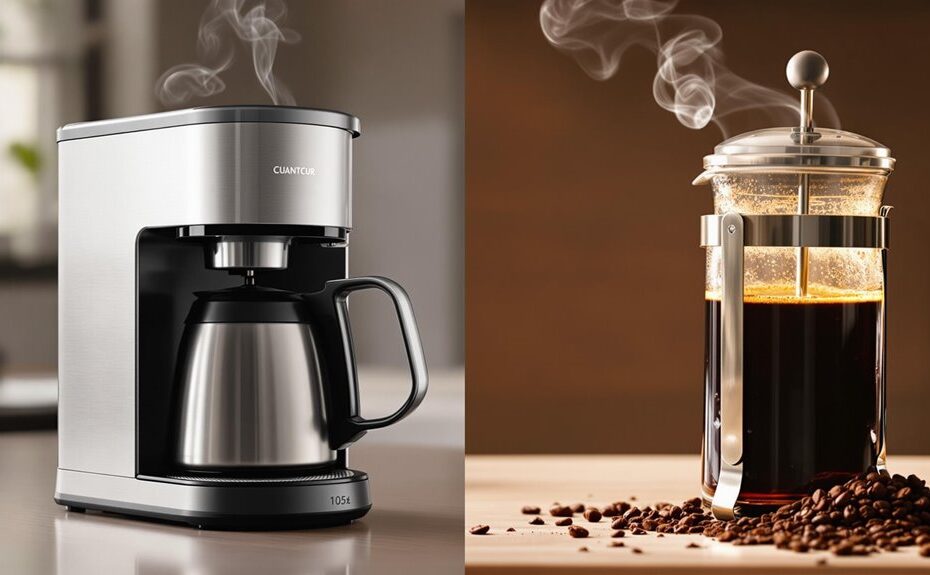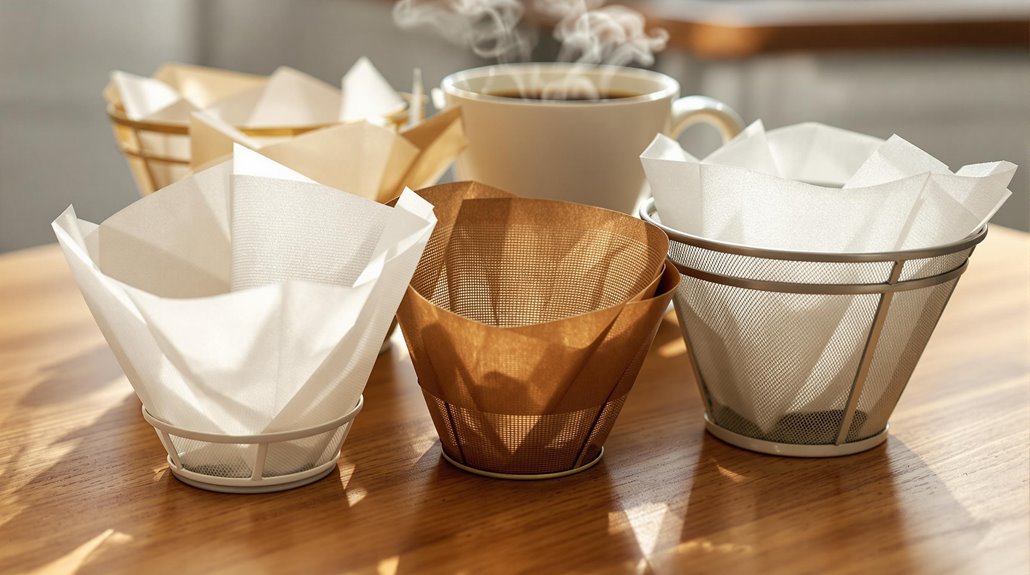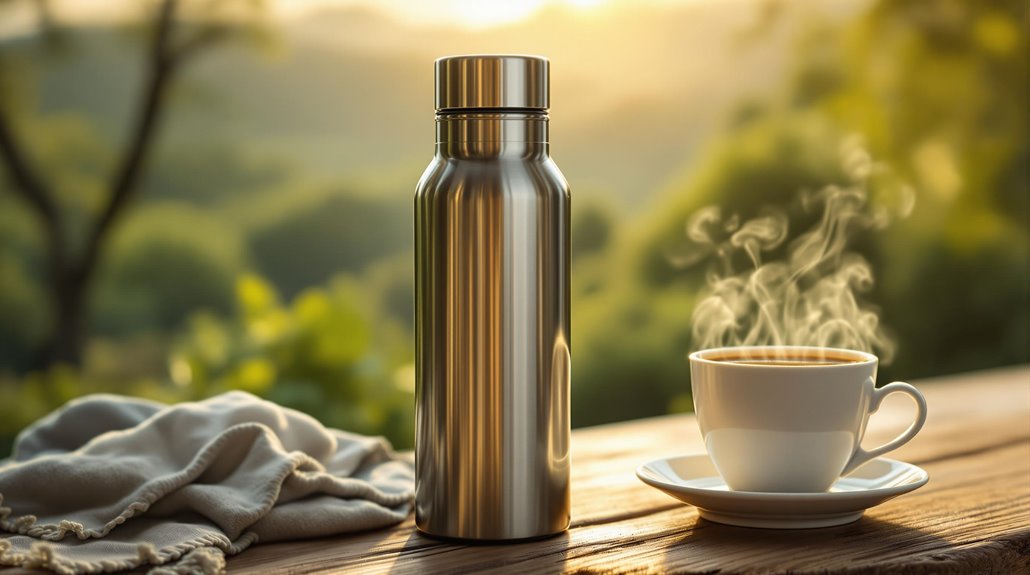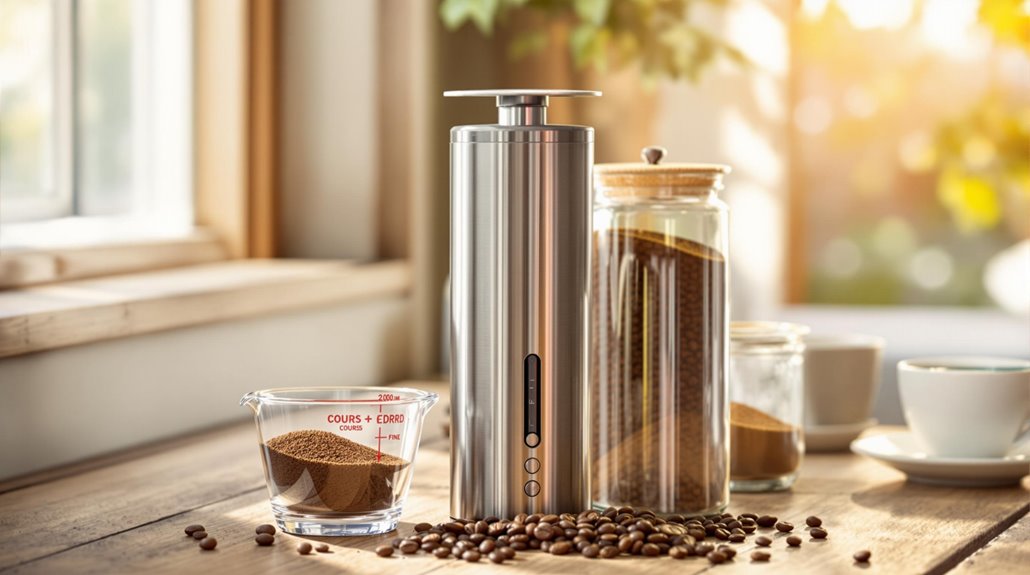







When you're deciding between a drip coffee maker and a French press, it's crucial to grasp how each method affects your coffee experience. You might value the convenience and consistency of a drip machine, or perhaps you favor the hands-on approach of a French press that enables greater control over flavor. Each brewing method has its own unique characteristics, from grind size to extraction time, which can markedly influence the final cup. So, what should you consider when choosing between these two popular options?
Key Takeaways
- French press uses immersion brewing with a manual steeping process, while drip coffee makers rely on gravity for automated extraction.
- French press requires a coarse grind, producing rich, full-bodied flavors; drip coffee makers use a medium grind for cleaner, milder tastes.
- French press allows for customizable strength and manual control over brewing time; drip coffee makers offer convenience with programmable settings and minimal effort.
- French press coffee retains natural oils and fine particles, potentially increasing cholesterol levels; drip coffee eliminates these, resulting in a cleaner cup.
- French press typically has higher caffeine content due to longer steeping times, while drip coffee averages lower caffeine levels due to quicker water passage.
Brewing Methods Compared
When you consider brewing methods, the stark contrast between a French press and a drip coffee maker becomes evident. The French press employs immersion brewing, allowing coffee grounds to steep directly in hot water for 4-6 minutes. This method promotes full-bodied flavor extraction as water interacts closely with the grounds. You control the steeping time and water temperature, which can substantially impact the final taste.
In contrast, drip coffee makers utilize gravity to draw water through a filter containing coffee grounds, typically taking 3-10 minutes for completion. This automated process offers convenience with programmable settings, making it easy to brew coffee without much oversight. However, it sacrifices some richness in flavor; the use of paper filters in drip coffee makers removes oils and fine particles, resulting in a cleaner but less robust taste.
Ultimately, your choice between these brewing methods hinges on your preference for flavor, control, and convenience. If you enjoy a hands-on approach and richer flavors, the French press suits you well. On the other hand, if you prefer automated ease, a drip coffee maker might be your best bet.
Coffee Grind Requirements
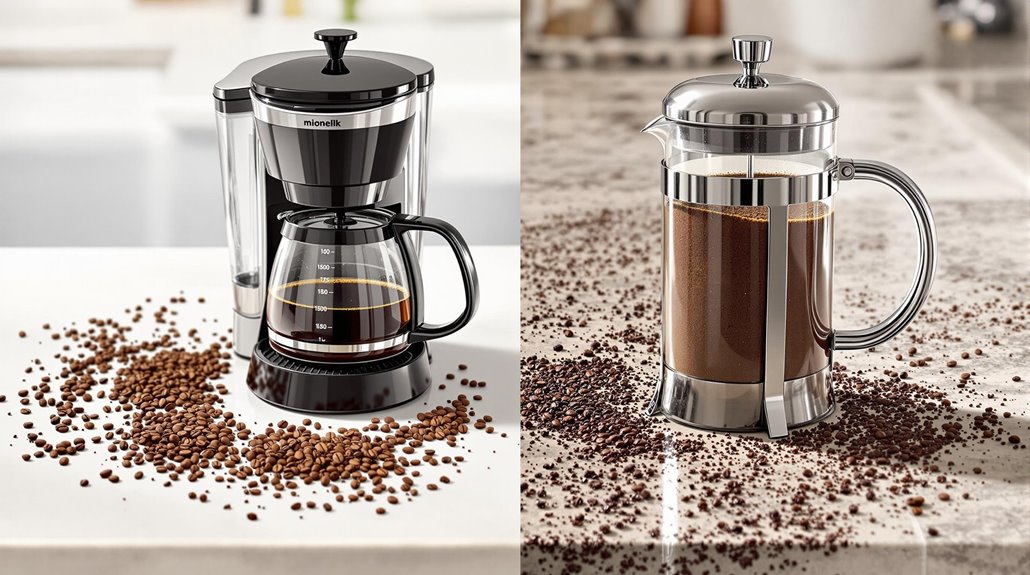
The grind size of your coffee beans plays a pivotal role in the brewing process, impacting both extraction and flavor. For a French press, you'll want to use a coarse grind. This prevents fine particles from passing through the metal filter, which can lead to sediment and a gritty texture in your final cup. The coarser grind requires a longer brewing time, allowing water to extract flavors more efficiently from the beans.
In contrast, drip coffee makers typically use a medium grind. This grind size optimizes extraction through paper or mesh filters, balancing the brewing time and the flavor extraction. If you were to use a fine grind in a drip coffee maker, you might find that it clogs the filter, resulting in an overly bitter brew.
Sometimes, a medium-fine grind is recommended for drip coffee to enhance flavor extraction while maintaining filtration efficiency. Ultimately, choosing the right grind size is essential for achieving the desired intensity and clarity in your coffee. Understanding these grind requirements can elevate your brewing game, ensuring you savor a well-balanced cup every time.
Flavor Profiles Explained
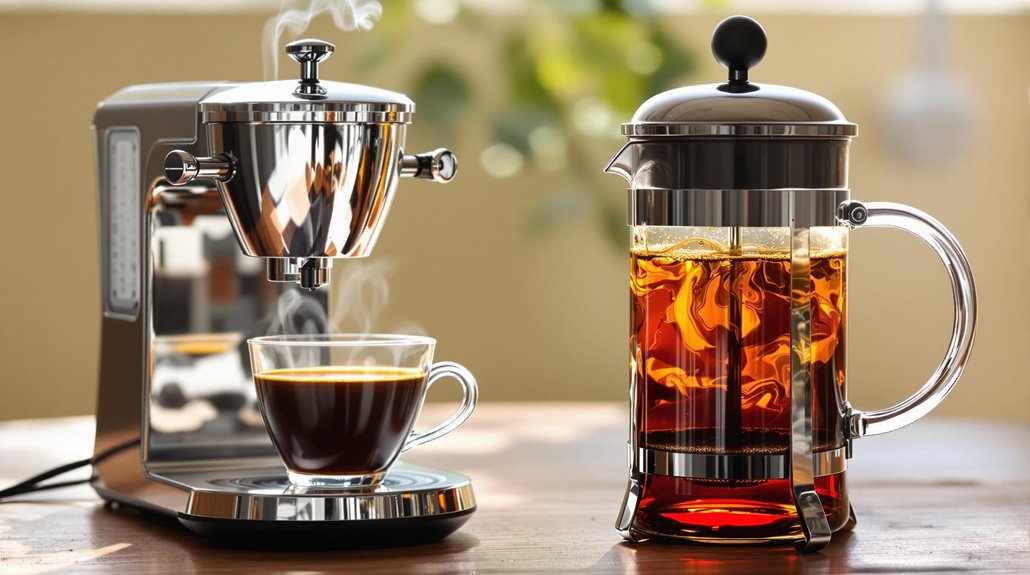
Understanding grind requirements sets the stage for exploring how brewing methods influence flavor profiles in coffee. When using a French press, the brewing process retains natural oils and fine particles from the coffee beans, resulting in a rich, full-bodied flavor with a slightly gritty texture. This method allows for longer steeping times of 4-8 minutes, which enhances the extraction of bold and robust flavors, showcasing the unique characteristics of the beans.
In contrast, a drip coffee machine employs paper filters that absorb oils and sediment, producing a cleaner, smoother, and milder taste. The shorter contact time of 5-10 minutes results in a lighter, more consistent flavor profile. This filtration process removes many of the nuanced flavors you'd experience with a French press, effectively dulling the coffee's complexity.
Ultimately, your choice between these two methods will substantially impact the flavor of your brew. If you prefer a more pronounced taste with depth and texture, the French press is the way to go. On the other hand, if you enjoy a clean cup with subtle notes, the drip coffee machine might be your best bet.
Control and Convenience
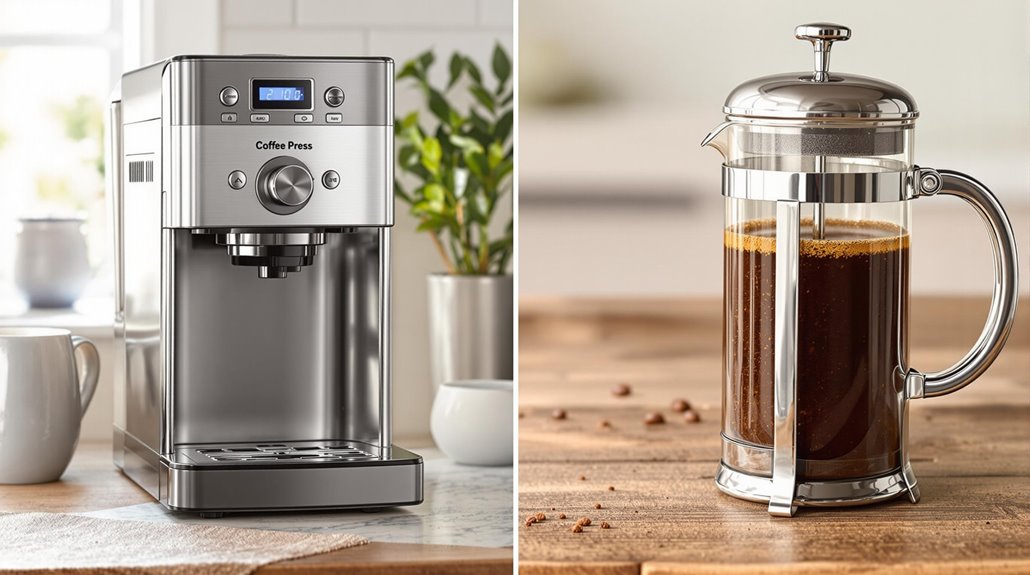
When it comes to control and convenience, your choice between a French press and a drip coffee maker substantially impacts your coffee experience. The French press allows you to customize brewing variables like water temperature and steep time, giving you the power to craft your ideal cup. In contrast, a drip coffee maker offers automated brewing, ensuring consistent results with minimal effort, perfect for those who prioritize convenience.
Manual vs. Automated Brewing
In the domain of coffee brewing, selecting between manual and automated methods greatly impacts your experience and the final taste of your cup. With a French press, you engage in a manual brewing process that requires your attention to detail. You control the steeping time, water temperature, and coffee-to-water ratio, allowing for a uniquely tailored brew. This hands-on approach means each cup can reflect your personal preferences, but it demands a level of involvement that some may find impractical.
On the other hand, drip coffee makers offer automated brewing, which prioritizes convenience. These machines often come with programmable settings that minimize user intervention, making them ideal for busy mornings or when brewing larger volumes. You simply fill the reservoir, set the timer, and let the machine do the work.
Choosing between these methods boils down to your preferences for control versus convenience. If you savor the process and enjoy experimenting with different variables, a French press might be your best bet. However, if consistency and ease are your priorities, a drip coffee maker will likely serve you better. Each method has its own merits, influencing not just your routine but also the flavor of your coffee.
Customization and Consistency
The choice between manual and automated brewing methods naturally leads to a discussion about customization and consistency in your coffee experience. When you opt for a French press, you gain significant control over brewing variables such as water temperature, steeping time, and coffee-to-water ratio. This level of control allows you to craft highly customized flavor profiles, adapting each cup to your personal preferences. However, this manual approach can lead to inconsistent results, as slight changes in the brewing process can affect the final taste.
On the other hand, drip coffee makers automate the brewing process, ensuring you get consistent results with minimal effort. Their programmable settings allow you to set brewing time and temperature, making it easy to replicate a perfect cup every time. If you prioritize convenience and uniformity, a drip coffee maker aligns better with your needs.
Ultimately, if you enjoy experimenting with brewing techniques and are willing to embrace the variability, the French press might be your ideal choice. Conversely, if you seek reliability and ease, a drip coffee maker is likely to be more suitable for your routine.
Filtration Techniques
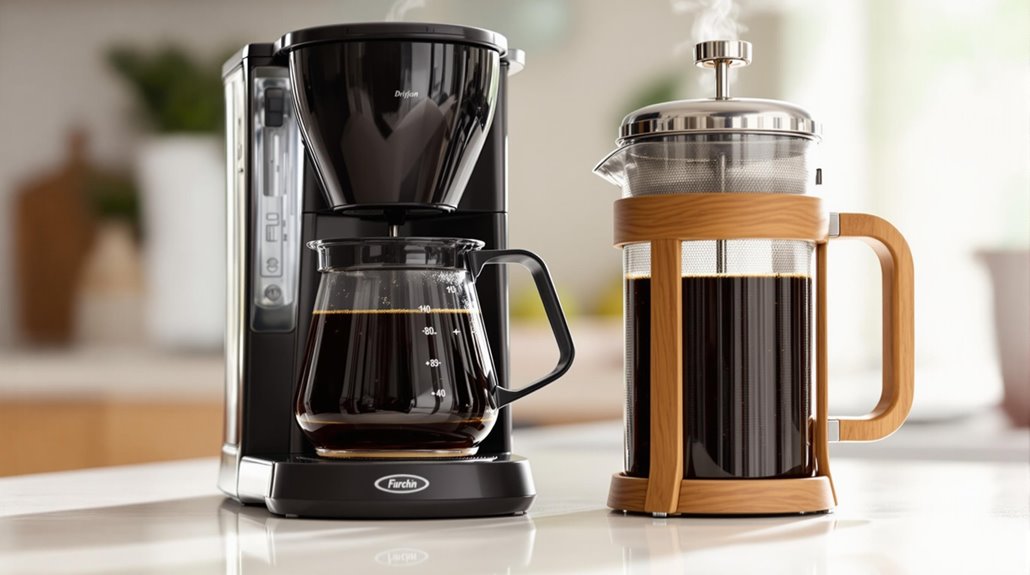
Choosing between a French press and a drip coffee maker often comes down to their distinct filtration techniques, which substantially influence the final cup of coffee. The French press employs a metal mesh filter that allows natural oils and fine particles to pass through, resulting in a fuller-bodied brew with a rich flavor profile. This method retains more of the coffee's essence, enhancing complexity and mouthfeel, but it does leave some sediment at the bottom of your cup.
On the other hand, drip coffee makers typically utilize paper filters, which effectively trap oils and fine grounds. This process produces a cleaner, smoother cup devoid of sediment, yet it may strip away some of the coffee's nuanced flavors. While the absence of oils reduces bitterness, it can also limit the depth of taste you might experience with a French press.
Moreover, the metal filter option in a French press is more eco-friendly since it eliminates the need for disposable paper filters. Ultimately, your choice between these brewing methods hinges on whether you prefer a robust, oil-rich profile or a cleaner, more straightforward cup.
Health Considerations
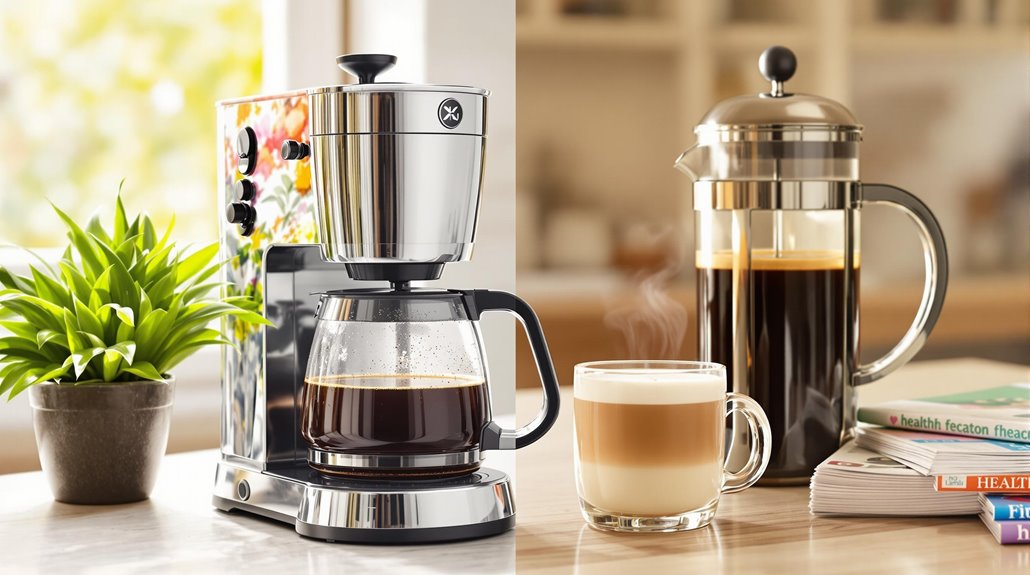
While both brewing methods offer unique flavors and experiences, health considerations play a pivotal role in deciding between French press and drip coffee maker. If you're concerned about cholesterol, you might lean towards a drip coffee maker. This method uses paper filters that effectively remove most oils and cafestol, which can raise LDL cholesterol levels. On the other hand, French press coffee retains more natural oils and fine particles, potentially elevating cholesterol levels for some drinkers.
However, if you're interested in antioxidants, the French press could be more appealing. Its minimal filtration allows for higher levels of beneficial compounds, offering potential health benefits. Yet, the sediment found in French press coffee may irritate your digestive system, making drip coffee a safer option if you're sensitive to fine particles.
Ultimately, your choice may depend on personal health priorities. If cholesterol management is a concern, the drip coffee maker is likely the better choice. But if you're seeking an antioxidant boost, the French press might win you over. Weighing these health factors can guide you in selecting the brewing method that best fits your lifestyle.
Caffeine Content Differences
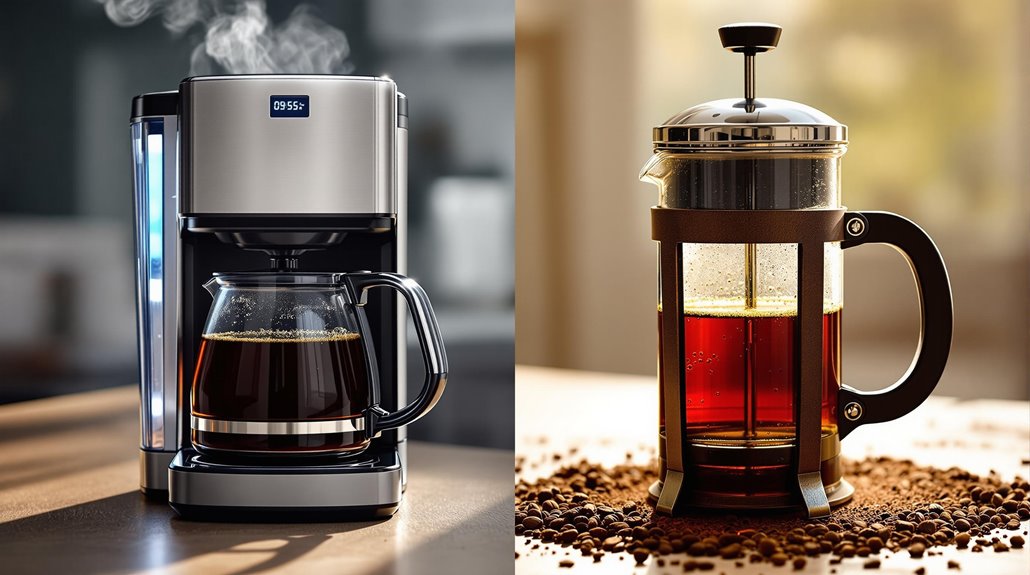
When comparing caffeine content, the extraction efficiency of each brewing method plays a pivotal role. French press coffee typically boasts higher caffeine levels per cup due to its longer steeping time, while drip coffee's quicker water passage results in slightly less caffeine. Understanding these differences can help you choose the right method based on your desired brew strength and caffeine kick.
Caffeine Extraction Efficiency
Understanding caffeine extraction efficiency reveals significant differences between drip coffee makers and French presses. The method you choose can impact the caffeine content in your cup. French presses typically extract more caffeine due to their longer steeping times and the full immersion of coffee grounds in water. This process allows for better saturation and extraction.
In contrast, drip coffee makers have lower caffeine extraction efficiency. The quick passage of water through the coffee grounds limits the contact time, reducing caffeine yield. On average, a French press can yield up to 107 mg of caffeine per 8 oz cup, while drip coffee averages around 95 mg for the same volume.
Moreover, the grind size plays a pivotal role in extraction. A coarse grind used in French presses allows for a slower caffeine release, enhancing overall extraction. In comparison, the medium grind in drip coffee may not release caffeine as effectively.
Finally, the coffee-to-water ratio and brewing time can also impact caffeine levels in both methods. However, if you're after a stronger caffeine kick, the French press often proves to be the better choice.
Brew Strength Comparison
Comparing brew strength between French press and drip coffee reveals notable differences in caffeine content that can influence your coffee experience. The brewing method plays a pivotal role in determining how much caffeine ends up in your cup. French press coffee typically boasts higher caffeine levels, ranging from 80 to 135 mg per 8-ounce cup, largely due to its full immersion brewing technique. This method allows water to extract more caffeine from the coffee grounds, especially when using a coarser grind size.
In contrast, drip coffee usually contains around 95 mg of caffeine per 8-ounce serving. The faster extraction process limits the amount of caffeine extracted compared to a French press. Additionally, the medium grind used in drip coffee machines doesn't release caffeine as effectively as the coarser grind favored by French press enthusiasts.
Steeping time also impacts the final caffeine content; longer steeping generally yields more caffeine. Consequently, if you're seeking a stronger cup, the French press might be your best bet, while drip coffee offers a milder option. Understanding these differences enables you to tailor your coffee experience to your caffeine needs.
Pros and Cons
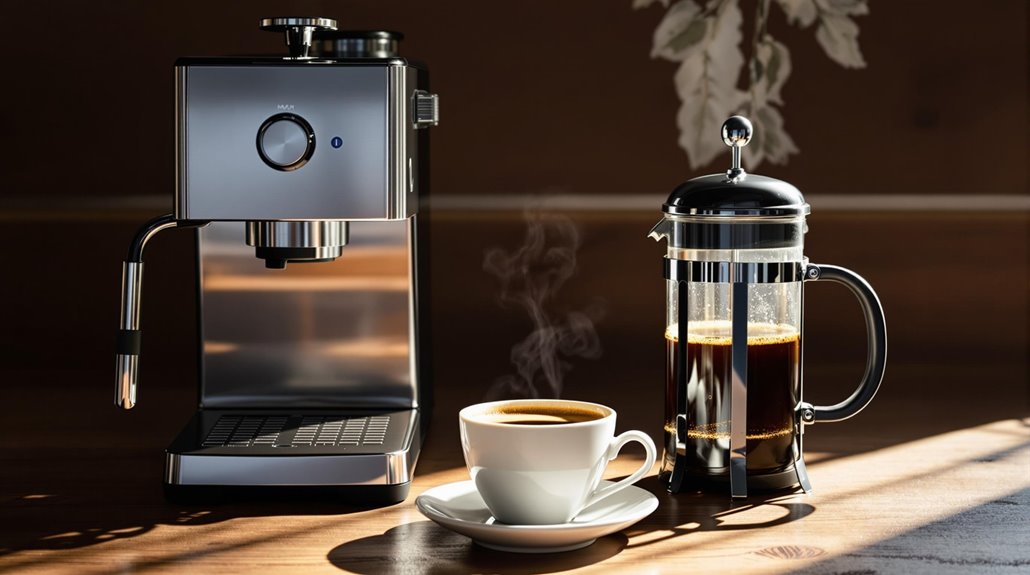
Choosing between a French press and a drip coffee maker involves weighing their distinct pros and cons. The French press is known for producing coffee with a strong flavor and a rich, full-bodied profile. This brewing technique retains the natural oils, enhancing taste, though it may leave some sediment in your cup. On the downside, using a French press requires manual effort and attention, making it less convenient for those with busy lifestyles.
In contrast, drip coffee makers offer a cleaner, milder taste due to their paper filters, making them ideal for those who prefer a smoother cup. They excel in convenience and automation, allowing you to brew larger quantities without much hassle. However, this ease comes with a trade-off; you might miss out on the depth of flavor that a French press provides.
Additionally, French presses are portable and don't need electricity, while drip coffee makers require a power source and can have higher maintenance costs. Ultimately, your decision may hinge on whether you prioritize strong flavor and control over convenience and quantity. Each method has its merits, so consider what best fits your coffee-drinking habits.
Design and Functionality
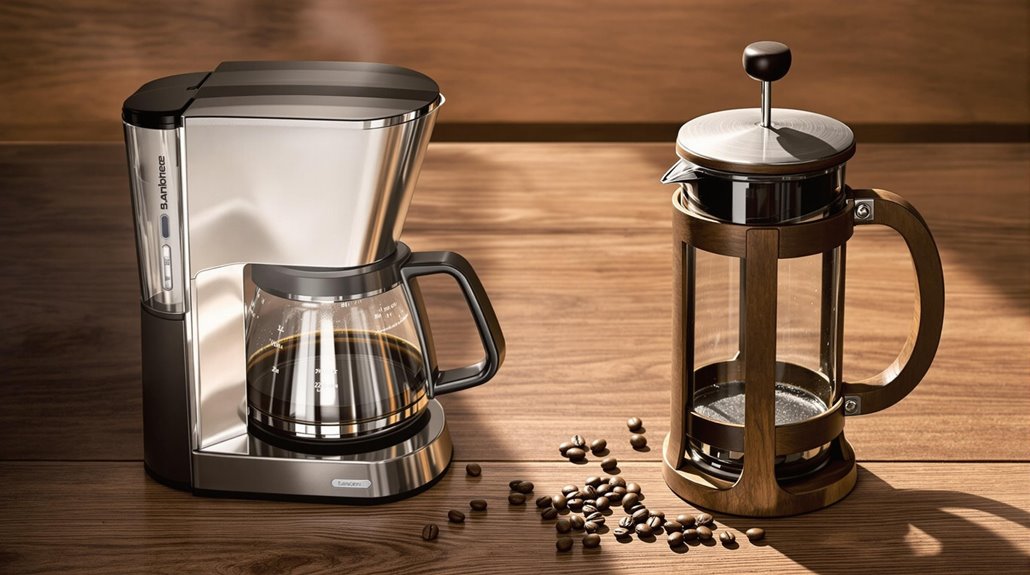
When considering design and functionality, you'll notice significant differences in the brewing mechanisms of French presses and drip coffee makers. The French press's manual steeping process contrasts sharply with the automated features of drip coffee makers, which often include programmable settings for convenience. Additionally, the materials and sizes of these devices vary, with French presses typically being smaller and more portable, while drip coffee makers can accommodate larger quantities suited for multiple servings.
Brewing Mechanism Differences
The brewing mechanisms of drip coffee makers and French presses highlight significant differences in design and functionality. Drip coffee makers employ a gravity-fed system where hot water drips through a filter containing coffee grounds. In contrast, a French press utilizes full immersion, steeping coffee grounds directly in hot water. This fundamental difference in brewing method influences the flavor extraction and strength of the final brew.
Drip coffee makers typically use paper or metal filters to trap the grounds, ensuring a clean cup. Conversely, the French press relies on a metal mesh plunger, which allows more oils and fine particles to pass through, resulting in a richer, fuller-bodied coffee.
The design of drip coffee makers includes a water reservoir, a heating element, and a carafe, automating the brewing process with programmable settings. On the other hand, a French press consists of a simple cylindrical beaker, plunger, and metal filter, requiring you to manually control the steeping time and plunging process.
Moreover, drip coffee makers cater to larger quantities and consistent brewing, while a French press shines with smaller batches, allowing for customizable strength and flavor profiles.
Material and Build Quality
Durability and design play pivotal roles in the performance of both drip coffee makers and French presses. French presses are typically constructed from glass, stainless steel, or plastic, emphasizing a cylindrical design with a plunger-filter mechanism. This simplicity contributes to their durability, as they have fewer moving parts and are easy to clean. Using a metal mesh filter, French presses allow oils and fine particles to pass through, enhancing the coffee's flavor profile.
In contrast, drip coffee makers often feature plastic or metal housings and come equipped with either glass or thermal carafes. Their design caters to automated brewing, making them suitable for larger batch sizes. Drip coffee machines generally include programmable settings and built-in heating elements, providing convenience but adding complexity to their build.
The choice between these two brewing methods also influences the resulting coffee. While French presses deliver a richer, more robust flavor due to their metal filters, drip coffee makers produce a cleaner cup, thanks to their reliance on paper or metal filters. Ultimately, the material and build quality of each option play significant roles in your brewing experience and the characteristics of the coffee you enjoy.
Size and Capacity Options
Choosing between a French press and a drip coffee maker also involves considering size and capacity options, which substantially affect their practicality in different settings. French presses generally range from 3 cups (12 oz) to 12 cups (51 oz), catering well to individual or small-group brewing needs. This compact design makes them perfect for travel or small kitchens, allowing you to enjoy fresh coffee without taking up much space.
On the other hand, drip coffee makers typically offer larger capacities, ranging from 4 cups (20 oz) to 14 cups (70 oz). This size makes them suitable for households or offices where multiple cups are brewed at once. Many drip machines also feature thermal carafes or glass carafes with warming plates, designed to keep coffee hot for extended periods, which can enhance your overall coffee experience.
When evaluating your brewing needs, consider how much coffee you usually prepare at one time. If you often brew for a crowd, a drip coffee maker may be the better choice. However, if you value portability and smaller batches, a French press could serve you well. Ultimately, your choice should align with your lifestyle and coffee habits.
Choosing Your Brewing Method
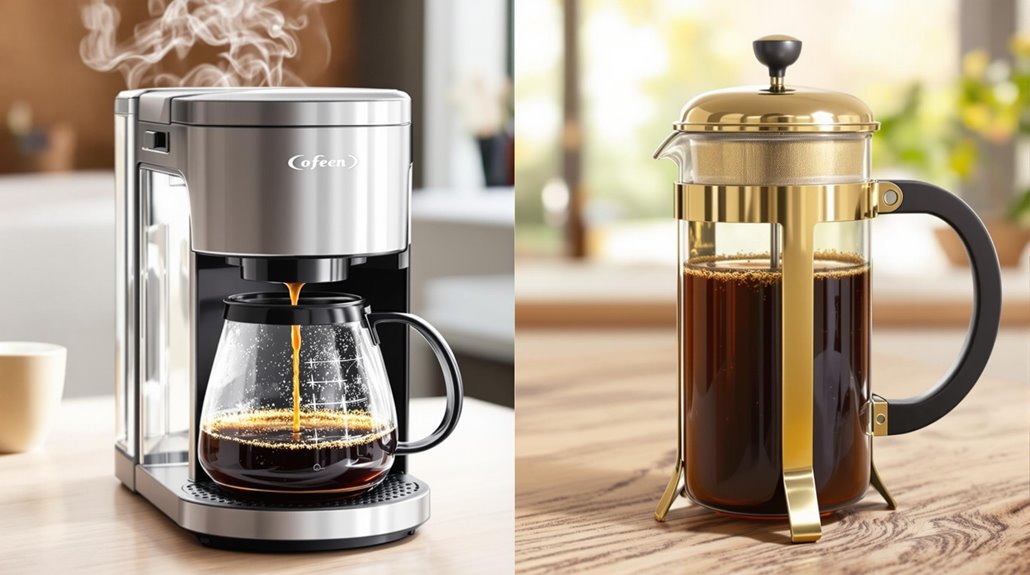
When it comes to selecting your brewing method, understanding the nuances between a French press and a drip coffee maker is essential. The French press employs an immersion brewing technique, allowing coffee grounds to steep in hot water for 4-6 minutes. This process extracts rich, full-bodied flavors that many coffee aficionados cherish. You have the flexibility to control brewing time and water temperature, tailoring each cup to your taste preferences.
In contrast, drip coffee makers utilize gravity to pass hot water through a filter filled with medium-ground coffee. This method produces a cleaner, milder taste, which may appeal to those who prioritize convenience over richness. The automated nature of drip coffee makers makes them an excellent choice for consistent, large-volume brewing, perfect for busy mornings or gatherings.
Ultimately, your choice hinges on whether you prefer the bold, textured flavor of a French press or the smooth, convenient cup offered by drip coffee makers. Consider your daily routine, how much time you want to spend brewing, and your flavor preferences when deciding on your brewing method. Each has its unique advantages, catering to different coffee-drinking experiences.
Disclosure: As an Amazon Associate, I earn from qualifying purchases.
